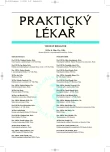Acute facial palsy – a comparison of clinical and laboratory parameters in patients with Borrelia and idiopathic aetiology
Authors:
E. Švecová; E. Vlčková; P. Štourač; J. Bednařík
Authors‘ workplace:
Přednosta: prof. MUDr. Josef Bednařík, CSc.
; Neurologická klinika LF MU a FN Brno
Published in:
Prakt. Lék. 2008; 88(8): 457-462
Category:
Of different specialties
Overview
Background:
Besides idiopathic (Bells) palsy, infectious diseases (in particular Lyme’s disease) represent the most frequent cause of acute facial palsy. The identification of patients with infectious aetiology based on clinical features and medical history however seems to be controversial according to published studies, and the examination of cerebrospinal fluid (CSF) is frequently not an integral part of the routine diagnostic algorithm of acute facial palsy.
Methods:
A detailed medical history, clinical neurological examination, routine biochemical and haematological laboratory screening, serologic tests for anti-borrelia antibodies and CSF analysis were performed in a group of patients admitted between I/2001 and XII/2005 to the Department of Neurology of the Brno University Hospital due to acute facial palsy.
Results:
24 patients (15 men, 9 women, mean age 54.5 ± 15.7) met the diagnostic criteria of American Academy of Neurology for borreliosis as the aetiology of acute facial palsy (Lyme disease group), while in 97 patients (51 men, 46 women, mean age 45.2 ± 17.5) the paresis was classified as Bells palsy (idiopathic group). Anti-borrelia antibodies were found in serum (but not in CSF) of 22 % of patients of the idiopathic group, which is not different from the incidence of these antibodies among healthy individuals in our region. History of tick-bites, headache and a presence of recently developed symptoms and/or signs of nervous system dysfunction except the affection of other cranial nerves were significantly more frequent in the Lyme disease group. One or more of these parameters were found in 18 patients (75 %) of the Lyme disease group but also in 32 patients (33 %) of the idiopathic group. Serum markers of inflammation and body temperature did not significantly differ between the groups.
Conclusions:
In spite of the fact that some clinical features and medical history data, as well as the presence of anti-borrelia antibodies in serum, considerably increase the probability of Lyme disease as the aetiology of acute facial palsy, none of these parameters alone or in combination with each other provides reliable possibility of the identification of the aetiology of acute facial palsy. Our findings thus support the importance of CSF examination as the integral part of diagnostic algorithm in acute facial palsy.
Key words:
Facial nerve, Bell’s palsy, Lyme disease, cerebrospinal fluid.
Sources
1. Bartůněk, P. a kol. Lymeská borrelióza. 3. vyd. Praha: Grada, 2001.
2. Bednařík, J. Hlavové nervy. In: Ambler Z, Bednařík J, Růžička E. Klinická neurologie. I. Část obecná. Praha: Triton, 2004: s. 223-398.
3. Berglund, J., Stjernberg, L., Ornstein, K. et al. 5-y follow-up study of patients with neuroborreliosis. Scand. J. Infect. Dis. 2002, 34, p. 421-425.
4. Bojar, M. Obrna lícního nervu. Cesk. Slov. Neurol. N. 2007, 70/103, s. 613-624.
5. Furuta, Y., Fukuda, S., Chida, E. et al. Reactivation of herpes simplex virus type 1 in patients with Bell´s palsy. J. Med. Virol. 1998, 54, p. 162-166.
6. Halperin, J.J., Logigian, E.L., Finkel, M.F., Pearl, R.A. Practice parameters for the diagnosis of patients with nervous system Lyme borreliosis (Lyme disease).Quality Standards Subcommittee of the American Academy of Neurology. Neurology 1996, 46, p. 619-627.
7. Hyden, D., Roberg, M., Forsberg, P. et al. Acute “idiopathic“ peripheral facial palsy: clinical, serological, and cerebrospinal fluid findings and effects of corticosteroids. Am. J. Otolaryngol. 1993, 14, p. 179-186.
8. Jäämaa, S., Salonen, M., Seppälä, I. et al. Varicella zoster and Borrelia burgdorferi are the main agents associated with facial paresis, especially in children. J. Clin. Virol. 2003, 27, p. 146-151.
9. Kohler, A., Chofflon, M., Sztajzel, R., Magistris, M.R. Cerebrospinal fluid in acute peripheral facial palsy. J. Neurol. 1999, 246, p. 165-169.
10. Ljostad, U., Okstad, S., Topstad, T. et al. Acute peripheral facial palsy in adults. J. Neurol. 2005, 252, p. 672-676.
11. Mauch, E., Vogel, P., Kornhuber, H.H., Hahnel, A. Clinical value of antibody titers to Borrelia burgdorferi and titer course in neurologic disease pictures. Nervenarzt. 1990, 61, p. 98-104.
12. Pachner, A.R., Steere, A.C. The triad of neurologic manifestations of Lyme disease: meningitis, cranial neuritis, and radiculoneuritis. Neurology 1985, 35, p. 47-53.
13. Roberg, M., Ernerudh, J., Forsberg. P. et al. Acute peripheral facial palsy: CSF findings and etiology. Acta Neurol. Scand. 1991, 83, p. 55-60.
14. Sobek, O. Adam, P. Zeman, D. a kol. Likvorové parametry u pacientů s neuroboreliózou. Klin. Biochem. Metab. 1998, 6, s. 229-234.
15. Vlčková, E., Švecová, E., Bourač, P. a kol. PCR diagnostika herpetických virů u pacientů s akutní „idiopatickou“ parézou lícního nervu. Cesk. Slov. Neurol. N. 2008, 71/104: s. 201-205.
Labels
General practitioner for children and adolescents General practitioner for adultsArticle was published in
General Practitioner

2008 Issue 8
- Metamizole vs. Tramadol in Postoperative Analgesia
- Metamizole at a Glance and in Practice – Effective Non-Opioid Analgesic for All Ages
- Memantine in Dementia Therapy – Current Findings and Possible Future Applications
- Hope Awakens with Early Diagnosis of Parkinson's Disease Based on Skin Odor
- Possibilities of Using Metamizole in the Treatment of Acute Primary Headaches
Most read in this issue
- Chronic damage of the triangular fibrocartilage complex
- Acute facial palsy – a comparison of clinical and laboratory parameters in patients with Borrelia and idiopathic aetiology
- Stenosis of the left subclavian artery as a cause of angina pectoris progression after CABG: coronary-subclavian steal syndrome
- Acute exacerbation of chronic obstructive pulmonary disease as seen by the intensivist
